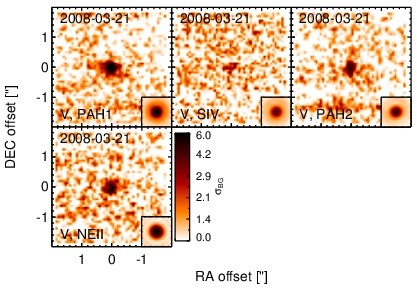Sasmirala Individual Information for NGC 4992
Description
NGC 4992 is an inclined spiral galaxy at a redshift of z = 0.0251 (D ~ 119 Mpc) with a little-studied AGN, which was discovered in hard X-rays with INTEGRAL [sazonov_identification_2005] and belongs to the nine-month BAT AGN sample. It has contradicting optical classifications as inactive nucleus [masetti_unveiling_2006], LINER [winter_optical_2010] and Sy 1.0 nucleus [veron-cetty_catalogue_2010]. The X-ray properties strongly suggest an obscured AGN [sazonov_identification_2005]. NGC 4992 was also detected with low-angular resolution radio observations [white_catalog_1997]. No detection was reported by IRAS, but it was also observed with Spitzer/IRAC and IRS and appears as a compact nucleus surrounded by weak spiral-like host emission in the corresponding images. The IRS LR staring-mode spectrum exhibits deep silicate 10 and 18 μm absorption and a blue spectral slope in νFν-space but no PAH emission or forbidden emission lines. This arcsecond-scale MIR SED, thus, also favours an obscured AGN. We observed NGC 4992 with VISIR in four narrow N-band filters in 2008 (partly published in [gandhi_resolving_2009]) and weakly detected a compact nucleus in all cases. In the three images with sufficient S/N, the nucleus appears possibly resolved but with inconsistent elongations/orientations. Therefore, we classify its subarcsecond MIR extension as uncertain. Our nuclear photometry is consistent with the previously published values and the Spitzer spectrophotometry. Therefore, we use the latter to compute the 12 μm continuum emission estimate.
- [gandhi_resolving_2009] P. Gandhi, H. Horst, A. Smette, S. Hönig, A. Comastri, R. Gilli, C. Vignali, and W. Duschl. Resolving the mid-infrared cores of local seyferts . A&A , 502 pp. 457–472, August 2009.
- [masetti_unveiling_2006] N. Masetti, L. Bassani, A. Bazzano, A. J. Bird, A. J. Dean, A. Malizia, L. Norci, E. Palazzi, A. D. Schwope, J. B. Stephen, P. Ubertini, and R. Walter. Unveiling the nature of INTEGRAL objects through optical spectroscopy. IV. a study of six new hard x-ray sources . A&A , 455 pp. 11–19, August 2006.
- [sazonov_identification_2005] S. Sazonov, E. Churazov, M. Revnivtsev, A. Vikhlinin, and R. Sunyaev. Identification of 8 INTEGRAL hard x-ray sources with chandra . A&A , 444 pp. L37–L40, December 2005.
- [veron-cetty_catalogue_2010] M.-P. Véron-Cetty and P. Véron. A catalogue of quasars and active nuclei: 13th edition . A&A , 518 pp. 10, July 2010.
- [white_catalog_1997] Richard L. White, Robert H. Becker, David J. Helfand, and Michael D. Gregg. A catalog of 1.4 GHz radio sources from the FIRST survey . ApJ , 475 pp. 479, February 1997.
- [winter_optical_2010] Lisa M. Winter, Karen T. Lewis, Michael Koss, Sylvain Veilleux, Brian Keeney, and Richard F. Mushotzky. Optical spectral properties of swift burst alert telescope hard x-ray-selected active galactic nuclei sources . ApJ , 710 pp. 503–539, February 2010.
Images

Optical image (DSS, red filter). Displayed are the central 4 arcmin with North being up and East to the left. The colour scaling is linear with white corresponding to the median background (BG) and black to the 0.01% pixels with the highest intensity.

Spitzer MIR images. Displayed are the inner 40 arcsec with North being up and East to the left. The colour scaling is logarithmic with white corresponding to median BG and black to the 0.1% pixels with the highest intensity. The label in the bottom left states instrument and central wavelength of the filter in micron (I: IRAC, M: MIPS).

Subarcsecond-resolution MIR images sorted by increasing filter central wavelength. Displayed are the inner 4 arcsec with North being up and East to the left. The colour scaling is logarithmic with white corresponding to median BG and black to the 75% of the highest intensity of all images in units of sig_bg. The inset image (where present; either bottom or top right) shows the central arcsecond of the PSF from the calibrator star, scaled to match the science target. The labels in the bottom left state instrument and filter names (C: COMICS, M: Michelle, T: T-ReCS, V: VISIR).
SEDs


MIR SED. The description of the symbols in all the SED plots (where present) is the following: Grey crosses and solid lines mark the Spitzer/IRAC, MIPS and IRS data. The colour coding of the other symbols is as follows: green for COMICS, magenta for Michelle, blue for T-ReCS and red for VISIR data. Darker-coloured solid lines mark spectra of the corresponding instrument. The black filled circles mark the nuclear 12 and 18 micron continuum emission estimate from the data (where present). The ticks on the top axis mark positions of common MIR emission lines, while the light grey horizontal bars mark wavelength ranges affected by the silicate 10 and 18 micron features.